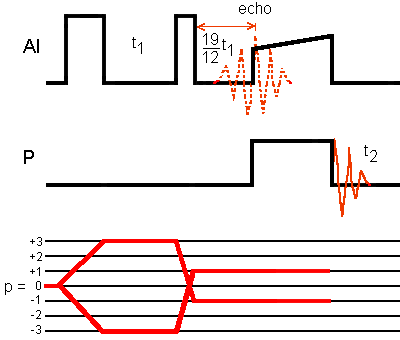Multiple Quantum HETeronuclear CORrelation
Wang and coworkers investigated 2D MQ-HETCOR spectrum, which provides connectivity information. They combined MQMAS experiment with Hartman-Hahn cross-polarization which can give a high-resolution HETCOR spectrum.
The quadrupole spin system is the source of cross-polarization and the spin-1/2 system nucleus is observed.

The -3Q-echo that forms at time 7*t1/9 after the second pulse is spin-locked and used as a source of polarization for the spin-1/2 system. In other words, the cross-polarization starts at the top of Na echo, the resulting P signal would synchronize the echo modulation of Na.
For a spin I = 3/2 and 3Q-HETCOR experiment, the echo pathway 0Q -> -3Q -> -1Q is involved. The mirror pathway 0Q -> +3Q -> +1Q is also selected by the phase cycling but for cross-polarization period.
ACQUISITION: Hyper-complex or TPPI
Shearing transformation is not required.
Fernandez and coworkers proved that the selection of both echo and anti-echo pathways of the quadrupole nucleus generates 'ghost' line in the 2D spectrum.

For spins I = 5/2, 7/2, or 9/2, and 3QMAS experiment, 0Q -> +3Q -> -1Q is the echo pathway.
As for spin I = 3/2 case discussed by Wang and coworkers, the mirror pathway 0Q -> -3Q -> +1Q is also selected by the phase cycling but for cross-polarization period.
ACQUISITION: Hyper-complex or TPPI
Shearing transformation is not required.
Steuernagel proposed another approach: The Na spin system after the pi/2 pulse is spin-locked and used as a source of polarization for the spin-1/2 system.

For a spin I = 3/2 and 3QMAS experiment,
0Q -> +3Q -> 0Q -> -1Q is the anti-echo pathway,
0Q -> -3Q -> 0Q -> -1Q is the echo pathway.
For spins I = 5/2, 7/2, or 9/2, and 3QMAS experiment,
0Q -> +3Q -> 0Q -> -1Q is the echo pathway,
0Q -> -3Q -> 0Q -> -1Q is the anti-echo pathway.
Selecting both pathways should generate pure absorption 2D lineshape.
ACQUISITION: Hyper-complex or TPPI
Shearing transformation is not required. The resolution along the F1 dimension is not as good as in MQ-MAS spectrum.
